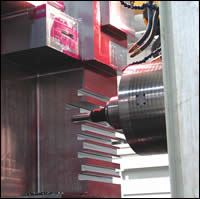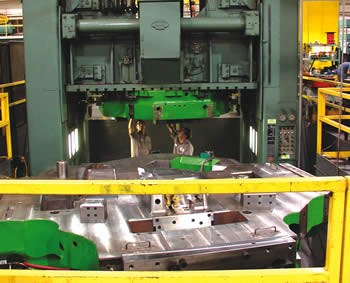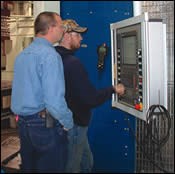Automotive Supplier Speeds Metal Removal With Boring Mill
In an industry where one in three shops has closed during the past 10 years, Fischer Tool and Die's business is thriving. According to the Temperance, Michigan shop, this is because its growth stems from die cast work for the automotive 'new domestics,' a term for transplants.
In an industry where one in three shops has closed during the past 10 years, Fischer Tool and Die’s business is thriving. According to the Temperance, Michigan shop, this is because its growth stems from die cast work for the automotive “new domestics,” a term for transplants.
The Fischer Tool & Die shop runs 7 days a week—24 hours per day Monday through Friday—and 16 hours on Saturday and Sunday. The size of the dies produced by Fischer is said to be one of its competitive advantages.
“We’re unique in the engine work we do in North America,” says Michael Fischer, president of Fischer Tool and Die. “The new domestics are now coming to us with multi-year programs.”
Work from Honda, Nissan and Ryobi accounts for most of the company’s 30- to 40-percent growth. The company also works with General Motors.
“You have to start with baby steps,” Mr. Fischer says. “Once we proved ourselves with small jobs, our business relationships starting growing.”
In 2005, Fischer decided to add a sixth boring mill to its 45,000-square-foot Michigan facility to produce large V6 engine block holder dies. Removing 45 percent of the stock from a 70,000-pound, six-foot square, 4140 steel billet block required a rigid, large-capacity machine. Fischer did its homework. The company evaluated machine tools, visited other manufacturers, requested test cuts and even reviewed operating manuals.
Ultimately, it decided on a PT 1800 plain-table boring mill from Giddings & Lewis Machine Tools (Fond Du Lac, Wisconsin). Featuring a modular design, the G&L boring mill allows Fischer to configure the machine to suit its requirements. As such, the company chose a 2,000 by 3,600 mm table, an extended Y-axis travel of 2,600 mm, a four-speed, 5-inch spindle headstock and an iTNC control from Heidenhain Corp. (Schaumburg, Illinois).
Close Heidenhain says that its controls offer ease of use and precision contouring capabilities, which can be especially useful in tool and die production. For instance, the plain-language programming is suited for shopfloor programming. In addition, the iTNC features a digital-drive control with an integrated inverter, which enables it to produce accurate workpiece contours while machining at high velocity. Commonality with the other machine tools in the factory is another benefit for Fischer.
“We’ve standardized on Heidenhain to control our training requirements,” Mr. Fischer says. “This makes it easier to shift operators wherever we need them.”
The cycle time on the V6 engine block holders is 900 hours. Therefore, the 4- to 5-week cycle time made machining speed an important consideration, says the company.
“With the amount of stock that must be removed, we also need a machine that would stand up to the deep cuts,” explains Bill Koch, general foreman at Fischer.
The PT 1800 has hardened and ground roller guide ways, and it achieves a rapid traverse rate of 25 m per minute. Accustomed to box ways, the company admits that it originally had concerns about the G&L linear way and roller truck system; that is, until the local Giddings & Lewis representative, Jim Foust of VMC Technologies, took the Fischer team to visit a local manufacturer that has been using the latest G&L boring mill design. After some discussion regarding the linear ways, Fischer decided that embracing the technology would better enable the company to compete in the global market.
A test cut performed at Giddings & Lewis further convinced the buying team that the PT 1800 and the 45 kW four-speed headstock they selected had the requisite rigidity and power. Large holes for lifting rings are machined into the engine block holders. These are cut with a two-inch tap that requires significant low-end torque. The low-end speed of the headstock is also important for sizing the pockets and achieving flat precise surfaces, the manufacturer says.
“The walls of a die must be straight and accurate,” Mr. Koch says. “To machine the deep die pockets, high speed mills are used. The standard through-the-spindle coolant supplied with G & L headstocks helps remove the large volume of chips produced.”
In the 7 months since the G&L boring mill was installed, the machine has been in operation nearly 4,500 hours. During that time, the machine has been taken out of service only 15 to 20 hours per week. Even running at this rate, the company had more work than it could handle.
“The new boring mill is achieving the desired results,” Mr. Koch says. “We’re experiencing a 20-percent increase in our metal removal rate with the PT 1800.”
These results contributed to the company’s decision to open a second plant, which will be closer to many of its customers in the South. One of the first machines to be installed will be a new Giddings & Lewis boring mill once Fischer determines the location of the plant.
“The PT 1800 has been a phenomenal machine—reliable, accurate and fast,” Mr. Fischer concludes. “It’s everything we want and need in a boring mill.”
Related Content
Inside an Amish-Owned Family Machine Shop
Modern Machine Shop took an exclusive behind-the-scenes tour of an Amish-owned machine shop, where advanced machining technologies work alongside old-world traditions.
Read MoreGrinding Wheel Safety: Respect The Maximum Speed
One potential source of serious injury in grinding comes from an oversight that is easy to make: operating the wheel in an over-speed condition.
Read More10 Things to Know About Creep-Feed Grinding
Because of the high material removal rate creep-feed grinding can deliver in challenging materials, grinding might not be just the last step in the process—it might be the process.
Read MoreWhen Organic Growth in Your Machine Shop Isn’t Enough
Princeton Tool wanted to expand its portfolio, increase its West Coast presence, and become a stronger overall supplier. To accomplish all three goals at once, acquiring another machine shop became its best option.
Read MoreRead Next
3 Mistakes That Cause CNC Programs to Fail
Despite enhancements to manufacturing technology, there are still issues today that can cause programs to fail. These failures can cause lost time, scrapped parts, damaged machines and even injured operators.
Read MoreThe Cut Scene: The Finer Details of Large-Format Machining
Small details and features can have an outsized impact on large parts, such as Barbco’s collapsible utility drill head.
Read More











.png;maxWidth=300;quality=90)







.png;maxWidth=300;quality=90)








